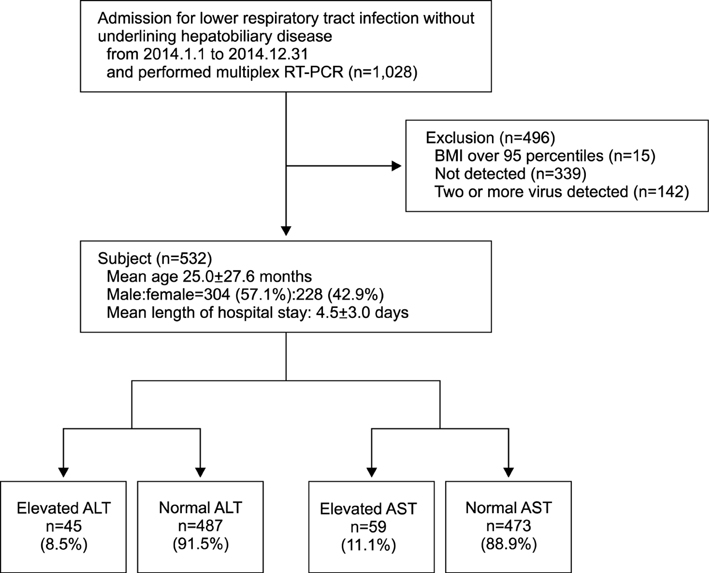Pediatr Gastroenterol Hepatol Nutr.
2016 Dec;19(4):243-250. 10.5223/pghn.2016.19.4.243.
The Relationships between Respiratory Virus Infection and Aminotransferase in Children
- Affiliations
-
- 1Department of Pediatrics, Konyang University College of Medicine, Daejeon, Korea. jmyoon@kyuh.ac.kr
- KMID: 2364765
- DOI: http://doi.org/10.5223/pghn.2016.19.4.243
Abstract
- PURPOSE
We sought to examine the relationship between the clinical manifestations of nonspecific reactive hepatitis and respiratory virus infection in pediatric patients.
METHODS
Patients admitted to the pediatric unit of Konyang University Hospital for lower respiratory tract disease between January 1, 2014 and December 31, 2014 and who underwent reverse transcriptase polymerase chain reaction tests were examined. The patients were divided into those with increased levels of alanine aminotransferase (ALT) or aspartate aminotransferase (AST) and those with normal ALT or AST levels. Further, patients with increased ALT and AST levels were individually compared with patients in the normal group, and the blood test results were compared according to the type of respiratory virus.
RESULTS
Patients with increased ALT or AST levels had one more day of hospital stay, on average, compared with patients in the normal group (5.3±3.1 days vs. 4.4±3.0 days, p=0.019). Patients in the increased ALT level group were younger and had a longer mean hospital stay, compared with patients in the normal group (p=0.022 and 0.003, respectively). The incidences of increased ALT or AST were the highest in adenovirus infections (6/24, 25.0%), followed by enterovirus (2/11, 18.2%) and respiratory syncytial virus A (21/131, 16.0%) infections.
CONCLUSION
Nonspecific reactive hepatitis is more common among patients with adenovirus, enterovirus and respiratory syncytial virus infection, as well as among those infected at a younger age. Compared with AST levels, ALT levels are better indicators of the severity of nonspecific reactive hepatitis.
MeSH Terms
-
Adenoviridae
Adenoviridae Infections
Alanine Transaminase
Aspartate Aminotransferases
Child*
Enterovirus
Hematologic Tests
Hepatitis
Humans
Incidence
Length of Stay
Respiratory Syncytial Viruses
Respiratory Tract Diseases
Respiratory Tract Infections
Reverse Transcriptase Polymerase Chain Reaction
Transaminases
Alanine Transaminase
Aspartate Aminotransferases
Transaminases
Figure
Cited by 1 articles
-
A Multicenter Study of Real-world Practice for Management of Abnormal Liver Function Tests in Children with Acute Infectious Diseases
Yoon Lee, Dae Yong Yi, Yoo Min Lee, So Yoon Choi, You Jin Choi, Kyung Jae Lee
J Korean Med Sci. 2021;36(47):e310. doi: 10.3346/jkms.2021.36.e310.
Reference
-
1. Squires JE, Balistreri WF. Manifestations of liver disease. In : Kliegman RM, Stanton BF, St. Geme JW, Schor NF, editors. Nelson textbook of pediatrics. 20th ed. Canada: Elsevier;2016. p. 1926.2. Steigmann F, Szanto PB, Meister HP, Pamukcu F. Clinical significance of nonspecific (reactive) hepatitis. Am J Gastroenterol. 1965; 44:129–137.3. Schaffner F, Popper H. Nonspecific reactive hepatitis in aged and infirm people. Am J Dig Dis. 1959; 4:389–399.
Article4. Kim TS, Hur TH, Lim SJ, Bin JH, Hahn SH, Kim SY, et al. A rise and fall in AST and ALT level in nonspecific reactive hepatitis. Korean J Pediatr. 2008; 51:396–400.
Article5. Jung BS, Oh JS, Cho B, Kim HH, Lee JS. A clinical study of respiratory tract infection in hospitalized children. Pediatr Allergy Respir Dis. 1996; 6:60–63.6. Elliot SP, Ray CG. Viral infections of the lower respiratory tract. In : Taussig LM, Landau LI, editors. Pediatric respiratory medicine. 2nd ed. Philadelphia: Mosby Elsevier Co;2008. p. 481–489.7. Lim JS, Woo SI, Kwon HI, Baek YH, Choi YK, Hahn YS. Clinical characteristics of acute lower respiratory tract infections due to 13 respiratory viruses detected by multiplex PCR in children. Korean J Pediatr. 2010; 53:373–379.
Article8. Radcke S, Dillon JF, Murray AL. A systematic review of the prevalence of mildly abnormal liver function tests and associated health outcomes. Eur J Gastroenterol Hepatol. 2015; 27:1–7.
Article9. Gahagan S. Overweight and obesity. In : Kliegman RM, Stanton BF, St. Geme JW, Schor NF, editors. Nelson textbook of pediatrics. 20th ed. Canada: Elsevier;2016. p. 307.10. Polakos NK, Cornejo JC, Murray DA, Wright KO, Treanor JJ, Crispe IN, et al. Kupffer cell-dependent hepatitis occurs during influenza infection. Am J Pathol. 2006; 168:1169–1178.
Article11. Jeon NL, Kim BS, Kim YK, Hong SJ. Etiology and clinical features of severe acute viral lower respiratory tract infections in children. J Korean Pediatr Soc. 2000; 43:1558–1568.12. Eisenhut M, Thorburn K. Hepatitis associated with severe respiratory syncytial virus-positive lower respiratory tract infection. Scand J Infect Dis. 2002; 34:235.
Article13. Eisenhut M, Thorburn K, Ahmed T. Transaminase levels in ventilated children with respiratory syncytial virus bronchiolitis. Intensive Care Med. 2004; 30:931–934.
Article14. Gopal DV, Rosen HR. Abnormal findings on liver function tests. Interpreting results to narrow the diagnosis and establish a prognosis. Postgrad Med. 2000; 107:100–102. 105–109. 113–114.15. Cohen JA, Kaplan MM. The SGOT/SGPT ratio--an indicator of alcoholic liver disease. Dig Dis Sci. 1979; 24:835–838.
Article16. Brumbaugh D, Mack C. Conjugated hyperbilirubinemia in children. Pediatr Rev. 2012; 33:291–302.
Article17. Appenzeller C, Ammann RA, Duppenthaler A, Gorgievski-Hrisoho M, Aebi C. Serum C-reactive protein in children with adenovirus infection. Swiss Med Wkly. 2002; 132:345–350.18. Kim KM. Paper presented at: 2010 Spring Symposium. Seoul, Korea: 2010. p. 70–76.
- Full Text Links
- Actions
-
Cited
- CITED
-
- Close
- Share
- Similar articles
-
- Clinical Characteristics and Severity of Respiratory Syncytial Virus Infection in Korean Children during the Post-COVID-19 Pandemic Period
- IL-5 and IFN-gamma Levels in Nasopharyngeal Secretions from Non-Asthmatic Wheezing Children with Respiratory Syncytial Virus, Influenza A Virus Infection and Asthmatic Children
- IL-11, IFN-gamma and ECP levels in nasopharyngeal secretions from non-asthmatic wheezing children with respiratory syncytial virus or influenza A virus infections
- Nosocomial respiratory syncytial virus infection in a newborn nursery
- Recovery of respiratory syncytial virus, adenovirus, influenza virus , and parainfluenza virus from nasopharyngeal aspirates from children with acute respiratory tract infections


